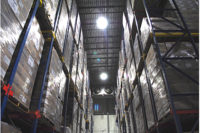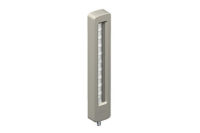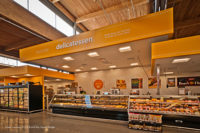Chill Out Over LED Lights

One of the most significant costs of operating a cold storage facility and the logistics associated with it is the expense connected with creating (and maintaining) a  cool environment. A refrigerated or frozen warehouse’s energy bill can vary by thousands or even tens of thousands of dollars each month, making the need to control energy costs and increase efficiencies critical to ensuring success and survival.
cool environment. A refrigerated or frozen warehouse’s energy bill can vary by thousands or even tens of thousands of dollars each month, making the need to control energy costs and increase efficiencies critical to ensuring success and survival.
Cold storage facilities require substantial amounts of electricity to maintain the proper temperatures necessary for preserving foods and beverages. In fact, electricity costs can comprise more than 25% of a cold storage building's ongoing operating costs, which at the end of the day, beats the other options of spoilage and lost products. But, those bills don’t have to be so painful.
In addition to the Illuminating Engineering Society of North America’s (IESNA) lighting recommendations, the United States Department of Agriculture (USDA) establishes minimum lighting requirements for food safety and minimum lighting recommendations for food security within and around a food processing facility, including the loading dock and warehouse areas.
In accordance with USDA regulations '416.2(c) Light, lighting of good quality and sufficient intensity to ensure that sanitary conditions are maintained and that product is not adulterated must be provided in areas where food is processed, handled, stored or examined; where equipment and utensils are cleaned; and in hand-washing areas.
Conventional lighting and refrigeration or frozen systems typically work against each other—lighting generates heat, which the refrigeration system needs to remove. In addition, lower temperatures reduce the energy efficiency of some types of bulbs. Therefore, more power is required to generate that desired illumination, which in turn increases the load on the refrigeration system. And, well, everyone knows how this story ends—increased energy bills.
So, what does that mean for the incandescent lights that have been used on the loading dock or cold storage facilities for, oh, ever? Toss ‘em! LED light output and efficiency (measured in lumens per watt) increases as the surrounding temperature falls. In one U.S. Department of Energy (DOE) study of refrigerated case lighting, LED efficiency increased by 5% at 23°F, compared to operation at 77°F. The improved performance of LEDs in cold temperature environments make them well-suited for refrigerated and freezer cases, cold storage facilities and processing plants.
But, now that we’ve established that LEDs are an excellent addition to any cold storage facility or processing plant, where do you start when selecting the best light for your application?
Loading dock lights should be rugged enough to withstand even the most severe forklift, trailer or product load impacts, as they can receive quite a beating. And, there are a variety of LED loading lights to choose from. For example, a dock light with a flexible arm moves the lamp out of the way upon impact and allows for easy repositioning. These lights have stainless-steel flexible arms for easy positioning and durability as well as approval from the USDA for food-grade applications and use. For the most demanding applications, a rugged, high-impact LED light is ideal and can be easily retrofitted to existing dock arms or can be mounted remotely. This option uses only 18 watts and also meets the stringent requirements for food applications.
Also, when determining which LED lights are best for your application, another factor to take into consideration is the various unloading and loading shift hours that exist. For overnight hours, you must ensure that your loading docks are well lit and likewise, that you have sufficient illumination inside the trailer. With replacement LED lamps available, you can easily update your dock lights without spending a ridiculous amount of money.
Before you begin a lighting project in your cold storage and transportation application, remember that LED lights are the perfect energy-efficient option to just about any facility.
Looking for a reprint of this article?
From high-res PDFs to custom plaques, order your copy today!





